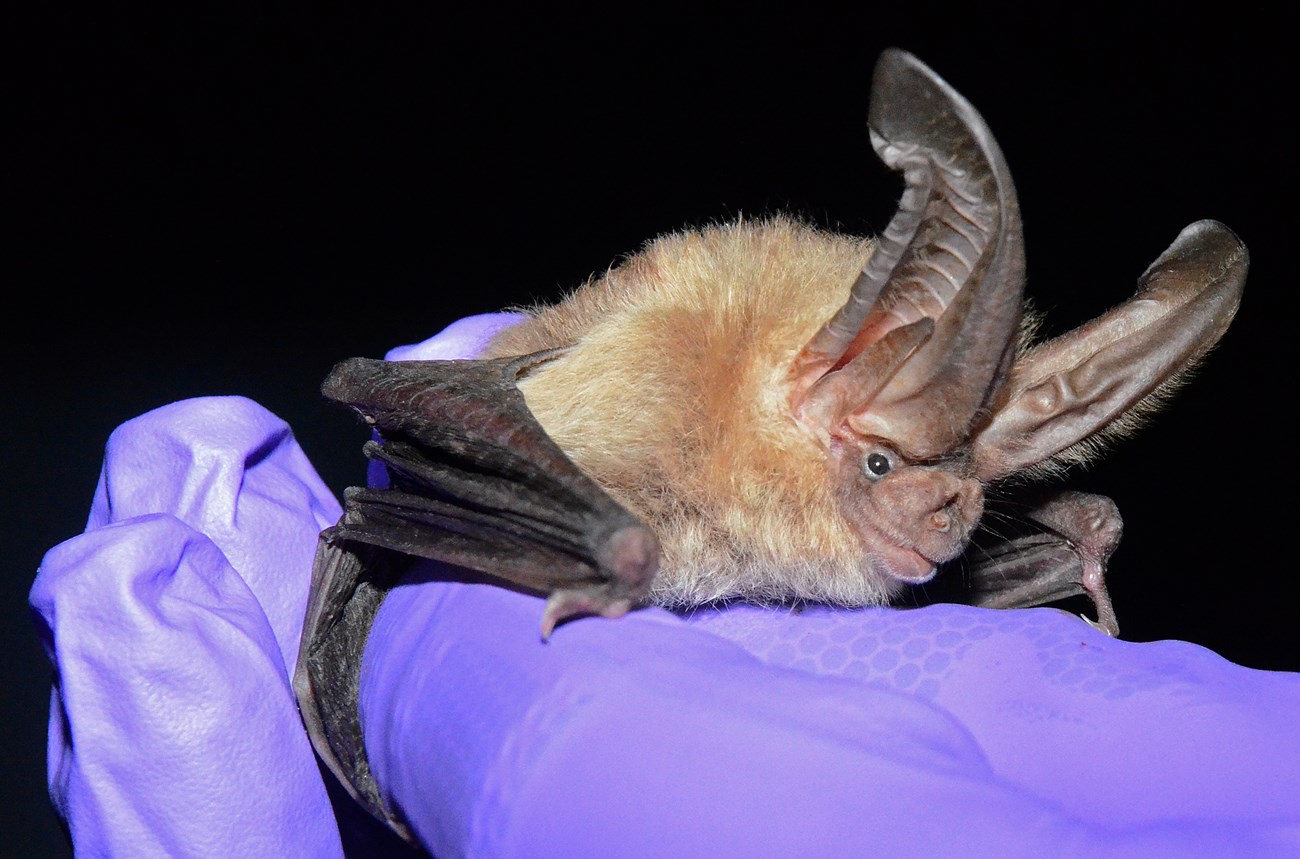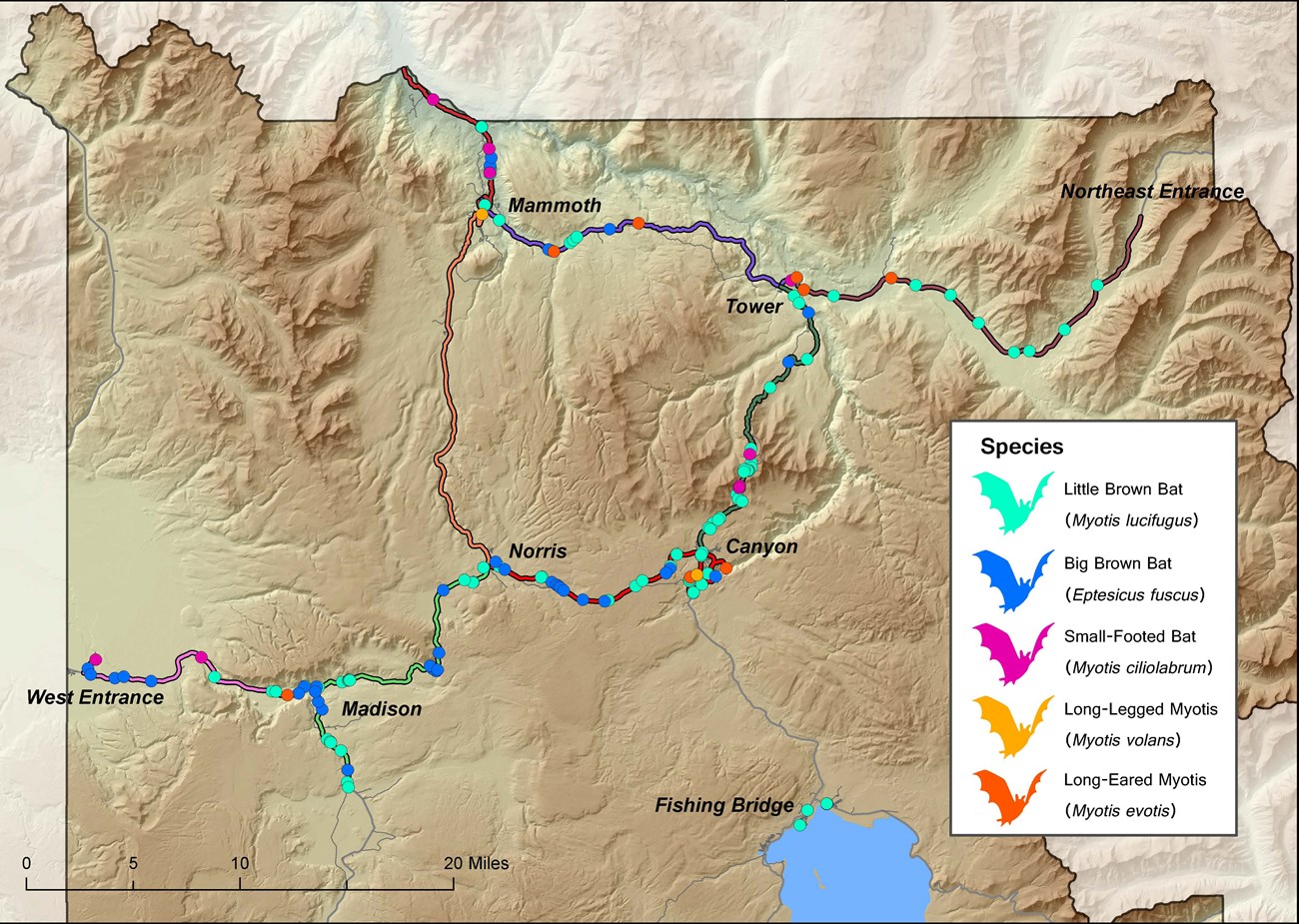Part of a series of articles titled Yellowstone Science - Volume 27 Issue 1: Vital Signs - Monitoring Yellowstone's Ecosystem Health.
Article
SHORT: Yellowstone bats important indicator ecosystem health

Yellowstone Bats: An Important Indicator of Ecosystem Health
by John J. Treanor, Joseph S. Johnson, Eli H. Lee, & Austin G. Waag
The popularity of Yellowstone National Park (YNP) is often gauged by the abundance of wildlife that calls it home, but the ecological health of the park is regularly assessed by a suite of indicator species. Bioindicators are typically species or species groups that are easily observed; however, a silent gray blur darting overhead at twilight may turn out to be an important indicator of environmental health. Despite their secretive nature, bats are believed to be excellent ecological indicators because they are sensitive to human-induced changes in climate and habitat quality (Jones et al. 2009). Bats are a diverse taxonomic group and their small size, high mobility, and wide distribution allow them to respond to disturbance in measurable ways. Thus, the long-term monitoring of bats may provide important insight into the ways in which biological communities are changing over time.
Currently, bat populations in North America are facing significant threats from climate change and the emerging infectious disease white-nose syndrome (WNS). Climate change is likely to influence wildfire regimes in the Greater Yellowstone Area (Westering et al. 2011). For bats in YNP, an increase in fire frequency could limit the availability of daytime roosts, often large dead trees, needed for reproduction by some species. Additionally, WNS continues to spread across North America, and the fungus that causes WNS was recently confirmed in bats from South Dakota and Wyoming. Cave hibernating bats in the eastern U.S. have declined by more than 90%, leading to worries of regional extirpations and extinctions (Frick et al. 2010). Most of the 13 bat species in YNP are expected to be susceptible to WNS and are poorly suited for recovery from substantial population declines because most species rear only a single pup per female each year. These impending threats from climate change and WNS highlight the need for a comprehensive, long-term monitoring program using innovative methods. Here we describe the components of YNP’s bat monitoring program and how these efforts are building the baseline data needed to identify impacts to bats over time.
Acoustic Survey and Mist Net Capture
Acoustic survey and mist net capture are the primary methods used to monitor bats in YNP. Acoustic monitoring is a noninvasive sampling technique that provides important information on the distribution of bat species and their activity over a large spatial area and across seasons. In YNP, acoustic sampling includes stationary point surveys and mobile transect methods. Point surveys allow researchers to deploy recording devices in remote areas of the park that log the echolocation calls of bats for extended periods of time without an observer present. This approach has been used to identify species that winter within the park and document bat activity across the summer. The western small-footed myotis is the species recorded most frequently during winter, while the little brown myotis is the most commonly recorded species during summer.
A shortcoming of acoustic data collected from the point surveys is that the level of bat activity does not necessarily correlate with abundance or density of bats because the automated detectors will continuously record multiple passes of individual bats. To address this limitation, mobile transects, which involve recording bats while traveling along road segments (15-30 miles; 25-48 km), have been used to estimate relative abundance of bats across the landscape. The recorded bat passes are assumed to represent an individual bat because the survey vehicle is traveling slightly faster than the maximum speed of most bats (Roche et al. 2011). In YNP, mobile transect surveys are used to track bat activity from spring to autumn (figure 1), which corresponds with migration and hibernation behaviors. Peak bat activity occurs in June and July, with approximately 26 calls recorded per hour of sampling. March and April have the lowest average number of detections with less than two calls per hour. The little brown myotis was the most commonly detected species with 38% of the recorded calls. Acoustic data is providing information on species-specific activity parkwide.
While acoustic sampling provides valuable data, some information can only be collected through direct observation of a bat in hand. For example, sex, age class, and reproductive status are determined only after capturing bats with mist nets. Mist net surveys can also identify the time of year when juvenile bats are becoming volant (i.e., able to fly), which, if delayed, may indicate habitat conditions have changed and pregnant females are struggling to find prey. Thus, a robust mist-netting program not only provides information on the bats captured, but also provides insight into the productivity of populations and the quality of their habitat.

Bat Migration and Roost Monitoring
For bats in YNP, the timing of hibernation and seasonal migrations are important responses to changing environmental conditions. Both events offer clues on how bats survive and reproduce in a region with severe winters and brief growing seasons. In the months following emergence from hibernation, female bats must devote enough energy to gestation and lactation to wean their young early enough to allow both mother and young time to accumulate critical winter fat reserves (Kunz et al. 1998). Yellowstone summers may put an energetic and time constraint on this process. Acoustic monitoring and radio-telemetry methods were used to document the timing of spring and autumn migration and to determine whether bats overwinter in YNP (Johnson et al. 2017). We detected acoustic activity of bats throughout the winter and were able to radio-track several species through late October—long past the cold-induced decline of insect prey. Bat activity dramatically increased between March and April, which is notable because daily minimum temperatures averaged less than 32°F (0°C) and may represent an adaptation to Yellowstone’s short summers.
For decades, bat monitoring included counting bats as they emerged from their daytime roosts. However, these emergence counts do not provide accurate estimates of the population using a particular roost. A novel approach to roost monitoring has been implemented in YNP using a radio-frequency identification (RFID) system. This technology is used to continuously monitor the population status of bats occupying individual attic roosts. The RFID monitoring system is recording bats (individually marked with tags) in three buildings spanning 24 miles (39 km) of YNP’s northern range. From 2015 to 2018, 301 female little brown bats were RFID-tagged providing nearly three million detections that included approximately 60% of the tagged bats. The implanted tags do not require batteries and are expected to operate for the lifetime of the little brown myotis, which may be over 30 years (Fenton and Barclay 1980). The monitoring system provides information on the fidelity of tagged individuals to specific buildings. The monitoring system also detects seasonal arrivals and departures from summer roosts, improving our understanding of bat migrations. Data from marked bats will allow biologists to track the survival of individuals and to monitor the productivity of bat colonies.
Long-term monitoring of biological indicator species, like bats, can be challenging and often requires substantial financial commitments. However, the importance of these types of programs cannot be overstated. Development of effective monitoring strategies can provide important insight into the ways in which biological communities change in response to climate change, habitat deterioration, and emerging infectious disease.
Literature Cited
Fenton, M.B., and R.M.R. Barclay. 1980. Myotis lucifugus. Mammalian Species 142:1-8.
Frick, W.F., J.F. Pollock, A.C. Hicks, K.E. Langwig, D.S. Reynolds, G.G. Turner, C.M. Butchkoski, and T.H. Kunz. 2010. An emerging disease causes regional population collapse of a common North American bat species. Science 329:679–682.
Johnson, J.S., J.J. Treanor, M.J. Lacki, M.D. Baker, G.A. Falxa, L.E. Dodd, A.G. Waag, and E.H. Lee. 2017. Migratory and winter activity of bats in Yellowstone National Park. Journal of Mammalogy 98:211-221.
Jones, G., D.S. Jacobs, T.H. Kunz, M.R. Wilig, and P.A. Racey. 2009. Carpe noctem: the importance of bats as bioindicators. Endangered Species Research 8:93–115.
Kunz, T.H., J.A. Wrazen, and C.D. Burnett. 1998. Changes in body mass and fat reserves in pre-hibernating little brown bats (Myotis lucifugus). Ecoscience 5:8-17.
Roche, N., S. Langton, T. Aughney, J.M. Russ, F. Marnell, D. Lynn, and C. Catto. 2011. A car-based monitoring method reveals new information on bat populations and distributions in Ireland. Animal Conservation 14:642-651.
Westerling, A.L., M.G. Turner, E.A. Smithwick, W.H. Romme, and M.G. Ryan. 2011. Continued warming could transform Greater Yellowstone fire regimes by mid-21st century. Proceedings of the National Academy of Sciences 108:13165-13170.
John Treanor is a Wildlife Biologist for the National Park Service working in the Yellowstone Center for Resources. He oversees the wildlife health laboratory and manages the Yellowstone wildlife health program, which addresses disease and health concerns in park wildlife. John has worked in Yellowstone since 2001 and currently supervises projects involving amphibians, rodents, bats, and ungulates in the park.
Last updated: September 18, 2019
